Written by: Lucian Alixandrescu | Commerical Cafe
- 60% of Americans are content with the balance between their work and personal lives with older workers finding work/life balance easier.
- Employees report that workplaces could primarily improve their work/life balance through complimentary snacks, quiet spaces and redecoration.
- More than 60% of respondents experience significant workplace stress, with difficult work environments and overtime being the most common sources.
- Family time overtook watching TV as the favorite free-time activity, being the preferred way to destress for 19% of respondents.
- 71% of Generation Z respondents plan to apply for a new job in 2024 with more than half of them citing higher salaries as the reason.
- Popular work/life balance resolutions for 2024 include reducing stress (26%), spending time with loved ones (17%) and getting better sleep (14%).
You don’t need to look to artificial intelligence to find a recent revolution in the workplace: In the years since the pandemic, an unprecedented degree of emphasis has been placed on workplace wellbeing and work/life balance. Specifically, mental health awareness — in conjunction with new factors, such as widespread remote work and hybrid models — have brought to the forefront an ongoing renegotiation of what work means.
So, to answer complex questions — such as how Americans of all ages feel about their work/life balance, the influence of remote work, as well as how all this stands to change in 2024 — we conducted a survey in which we asked 1,377 respondents a set of questions pertaining to workplace wellbeing. We then split the results by generation to further highlight the differences in how Americans of all ages draw the line between their professional and personal lives, as well as their career plans for 2024.
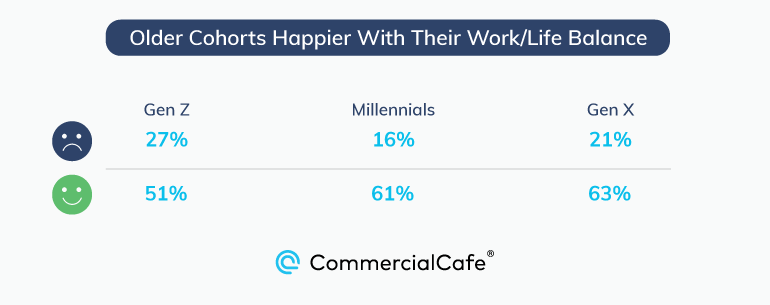
On average, around 60% of all respondents are satisfied or very satisfied with their work/life balance, while around 20% are dissatisfied or very dissatisfied. The rest felt indifferent on the subject. However, the generational divide showed that Generation Z was far more concerned about this balance — a fact that echoed the findings of our previous work/life balance survey from last year.
A total of 27% of Zoomers report being partially or wholly dissatisfied with their work/life balance, compared to 16% of Millennials and 21% of Generation Xers. Conversely, just over half of Generation Z participants are at least somewhat satisfied with how they combine work and personal life. Gen Z’s ongoing issues in separating their work and personal lives may stem from a higher degree of mental health awareness, but also from their status as fresh entries in the workforce.
At the same time, only 38% of members of Generation Z said they would be willing to accept a lower salary in exchange for a better work/life balance, which was on par with Generation X. For comparison, 45% of Millennials were willing to make the trade-off, despite feeling less pressured by their work/life balance, on average.
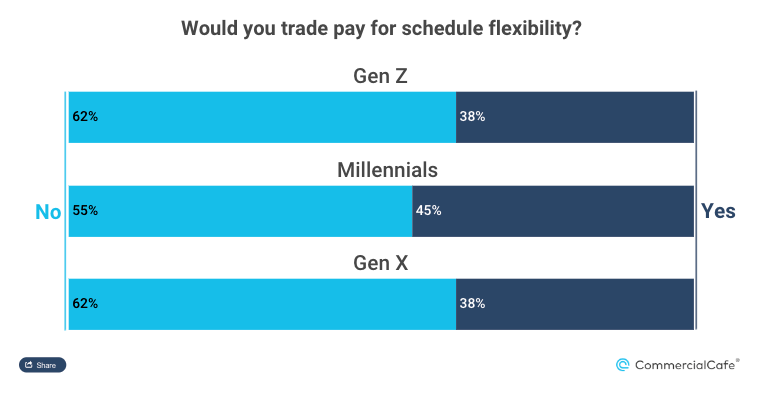
All of this points to the fact that younger workers are still learning healthy ways to manage their professional lives — an endeavor that may be impeded by the need to stand out and progress in their careers. Of course, all generations struggle with striking this balance to varying degrees.
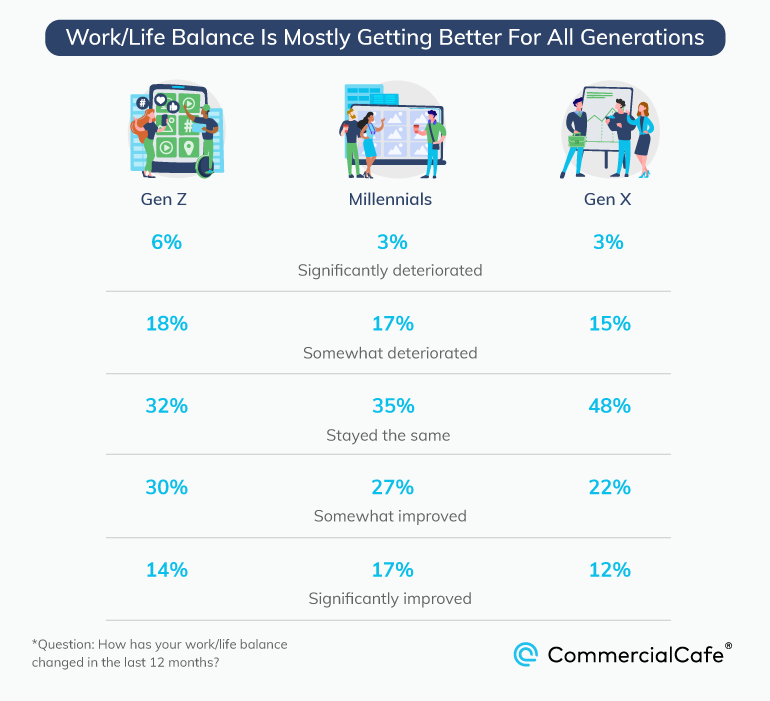
When asked about how their work/life balance had shifted in the last 12 months, responses generally followed the same generational divide: Around 44% of Zoomers felt some degree of improvement, whereas 24% said the divide between work and personal life had deteriorated to some extent and the remaining 32% felt no change. Similarly, Millennials mostly echoed the sentiments of Gen Z, although they were slightly more likely to perceive no change than a negative one.
Meanwhile, almost half of Generation X said their work/life balance had not changed in any meaningful way in the last 12 months with 34% perceiving a positive change and the remaining 18% reporting a negative direction. This can partly be attributed to the general trend of older generations feeling less strongly about workplace wellbeing. However, another important variable is that of remote work, which can greatly alter how respondents feel about their workplace mental health.
Generation X Most Appreciative of Remote Work Benefits
To identify the role of working from home in the current work/life balance debate, we also asked respondents to rate how much working from home helped them find that balance (or how much it could help, for those who don’t work from home).
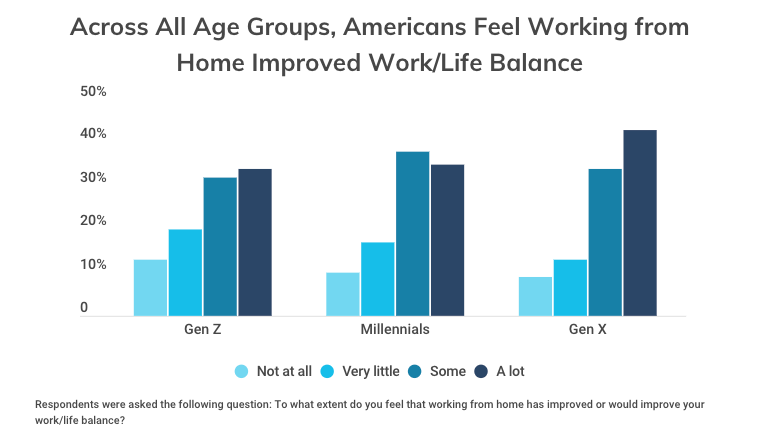
More than one-third of all respondents — regardless of age — said that working remotely has helped or could help them balance work and life a lot, with an additional 33% reporting that it would help them somewhat. This highlights the ability to work remotely as an important factor in perceived worker wellbeing.
Still, another generational divide was evident, with Generation X favoring remote work more than the two younger generations. In fact, as many as 43% of Gen Xers said working from home helped or could help them a lot, compared to 35% of Millennials and 34% of Gen Zers. Conversely, only 9% of Gen Xers said telecommuting has not helped or would not help at all (versus 13% of Zoomers).
It’s worth noting that a larger share of Zoomers and Gen X managed to achieve their goal of remote work flexibility: The largest work model shift for those generations was from on-site work to remote work with 29% and 27% of work model changes, respectively. Even so, the trend was opposite for Millennials as 25% of changes in their work arrangements were switching from fully remote work to hybrid, and a further 23% were switches from fully remote work to fully on-site work.
However, these changes were not necessarily willful as 45% of office-working respondents (regardless of age group) said they had returned to on-site work because it was required by their employer. A further 9% did so due to transitioning to an exclusively on-site job. Lastly, the positive effects of working in-office — such as face-to-face interaction and increased networking — were chosen by less than 5% of respondents as the reason for their return to the office.
Hybrid & Remote Work Metrics: Millennials Spend Most Time in Office, Gen X Widely Adopts Coworking Spaces & Cafes
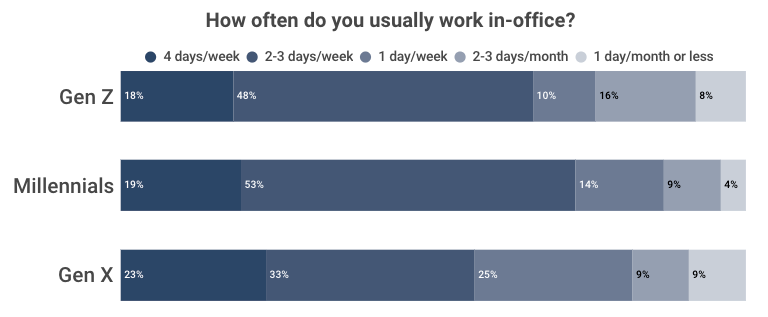
To shed more light on the current state of hybrid work in the U.S., we then asked respondents who said they currently had a hybrid working schedule about how often they worked in the office. By and large, 44% of hybrid workers were in-office for two to three days per week, splitting their time between on-site and at-home work relatively evenly. However, the share of Gen Zers and Millennials in this category was far greater than that of Gen Xers.
Overall, Millennial hybrid workers spend the most time in the company office, with more than 53% of them working on-site two to three days per week. Another 19% say they spend four days per week in the office.
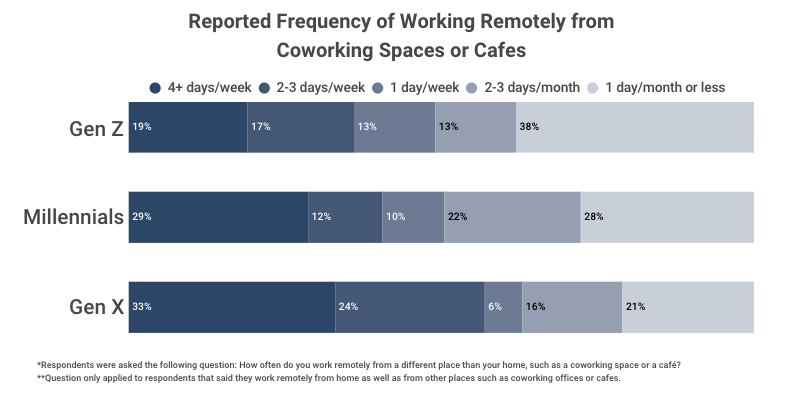
Respondents could also report whether they worked remotely exclusively from home or if they telecommuted from other places with internet access, such as cafés and coworking spaces. We also asked the latter how often they chose a change of setting while telecommuting in coworking spaces and other potential remote work locations.
Interestingly, Generation X was the most faithful proponent of working from third spaces with 33% reporting that they telecommuted from a coworking space or café four days per week or more. Another 24% responded “two to three days per week.” Clearly, telecommuting from a different place other than home can greatly benefit the work/life balance because working from home full-time can blur the lines between work hours and downtime.
Millennials also welcomed the coworking trend: 29% of members of this cohort who worked remotely said they logged on from a coworking office or café four or more days per week. Yet, for Gen Zers, working from a different location was more of an occasional change of pace than a regular occurrence as 38% of them said they left their home office one day per month or less.
In Search of Workplace Wellbeing, Workers Demand Refreshments & Rest Spaces
In a world where work isn’t only done in the office and where office spaces — whether company-owned or shared — often serve as hubs for collaboration and interaction, companies and owners alike are hard-pressed to offer employees more reasons to spend more time on-site, rather than telecommuting. For this reason, we also asked respondents about what measures their company office or coworking space could take to improve their work/life balance (and, thus, encourage them to work on-site).
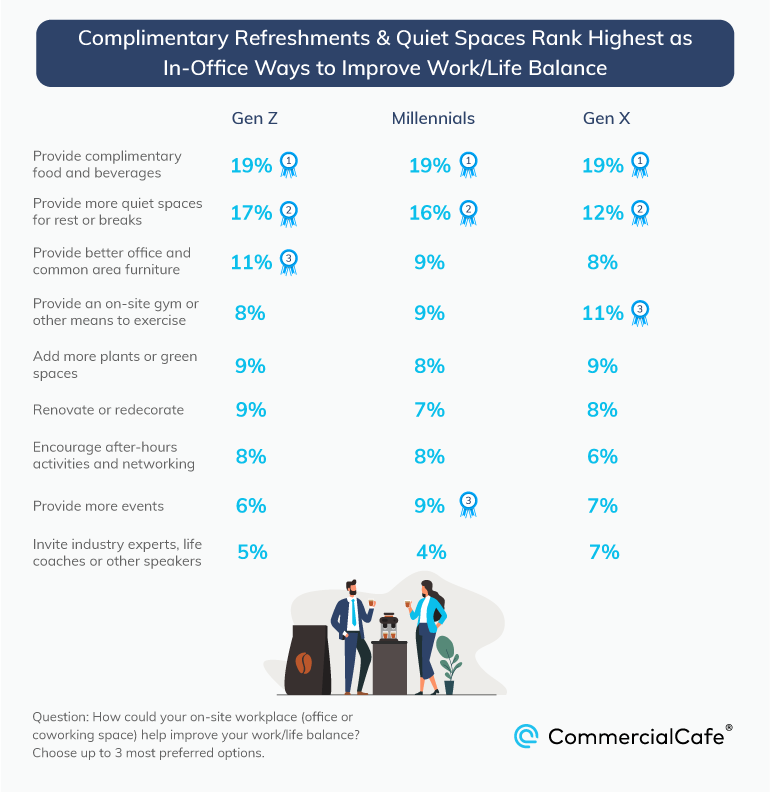
Logging 19% of responses across all age categories, the most common request from workers was for complimentary food and beverages — an advantage commonly offered by coworking spaces that could also be relatively easy to achieve for traditional office spaces, as well. Then, the next-most desired improvement for work/life balance was that of additional quiet spaces for employees to recharge their batteries, with Gen Zers requesting this improvement the most.
After these two common denominators in office and coworking amenities, each generation expressed different priorities in office work/life balance improvements. Namely, the next-most popular requests for Generation Z were better office and common area furniture, as well as design improvements, such as renovations, redecorations and the inclusion of more green spaces. Meanwhile, Millennials prized networking and comfort by requesting events, as well as improved office furniture. Generation X’s main request (besides complimentary snacks and quiet spaces) was an on-site gym.
Difficulties in Switching Off & Hard Work Environments Cited as Main Sources of Stress
Aside from their level of success in separating their profession from their personal life, we also looked into how stressed workers felt as a result of their work, as well as the causes that primarily contributed to their stress levels.
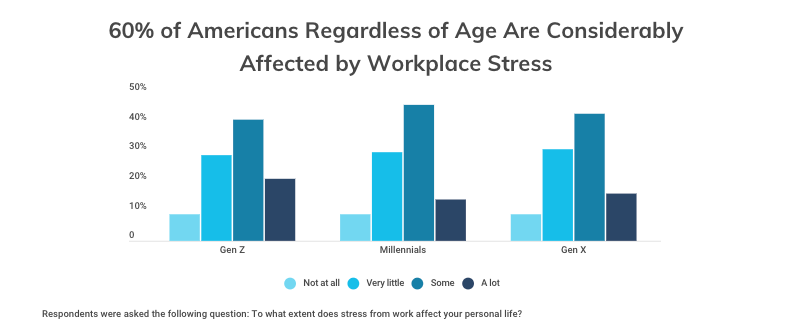
More than 60% of all respondents said they are at least somewhat affected by workplace stress with 17% of all respondents further responding that their personal life is significantly affected by it. In this case, younger respondents felt more affected by workplace stress with 21% of Generation Zers saying it affects them a lot.
While respondents cited a variety of sources for their stress, the foremost was a difficult or toxic work environment. This was the primary source of stress for close to one-third of respondents in all three age groups. Remaining answers were relatively evenly split between reasons such as tight deadlines, overtime, and getting work calls or emails after hours. At any rate, the epidemic of workplace stress is a complex one to tackle, although there may be some common denominators.
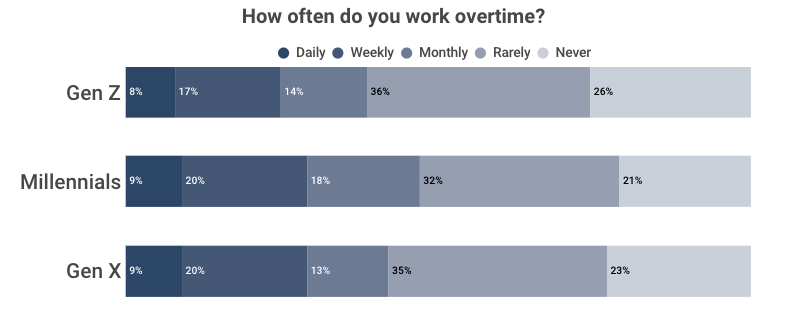
As you might expect, overtime and burnout contribute greatly to workplace stress, and around 30% of respondents work overtime at least once a week with one-third of them saying they worked extra hours daily. Among full-time employees, Millennials had the most hours worked per week at 44.7, on average. They were followed by Generation Z with 44.5 hours and Generation X with 43.9 hours.
However, logged overtime hours aren’t the only form of work-related activities that employees conduct even after their regular schedule. Here’s how often the polled workers said they checked emails or did other work-related activities even after their work hours were over:
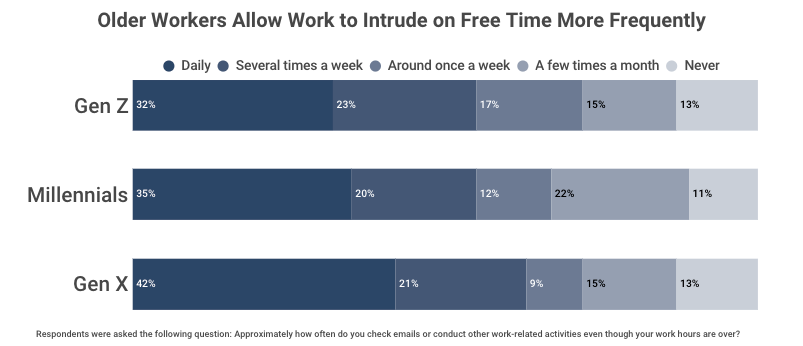
Hidden overtime — such as checking emails or taking calls after hours — is a daily occurrence for 32% of Zoomers, 35% of Millennials and 42% of Gen Xers. Despite the fact that research has repeatedly underscored the importance of completely disconnecting from work once the workday is done, the advent of hidden overtime (alongside that of remote work) has negatively affected work/life balance across the board.
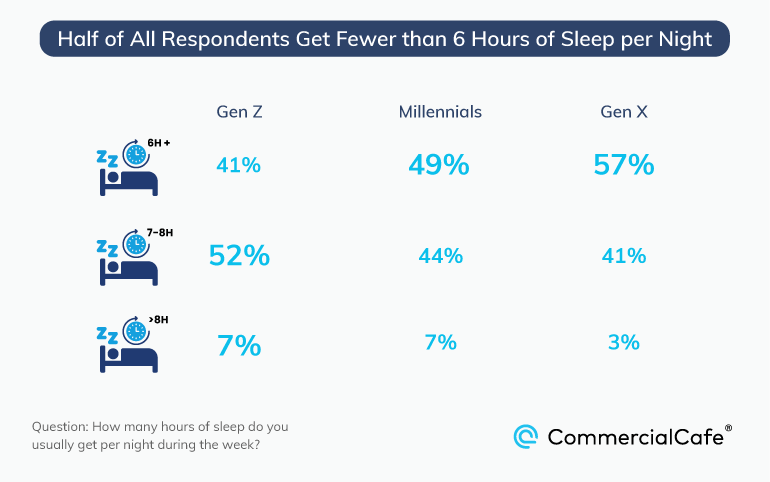
At the same time, chronic lack of sleep can also have terrible consequences on employees’ mental health. Whether it’s due to a difficult work schedule or personal arrangements, almost half of all respondents said they got six or fewer hours of sleep per night — less than the recommended minimum of seven hours for long-term health and productivity. Older respondents generally got even less sleep than their younger counterparts, but younger workers were more likely to still feel tired even after a full night’s sleep.
To Destress, Workers of All Ages Turn to Family & Friends
When it comes to blowing off steam, the most popular destressing activity among all age groups was spending time with family and friends. This marked a change from last year’s survey, when watching TV or streaming services was the most popular free-time activity for all age groups. Therefore, people are now pursuing more meaningful interaction to break away from the daily grind.
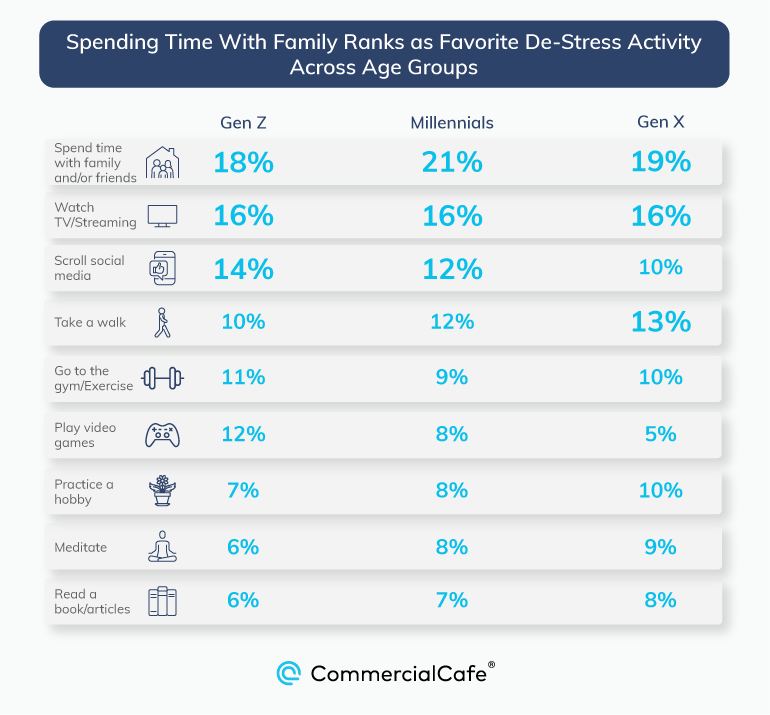
Watching TV or streaming services was still the second-most popular de-stressor and one of the favored activities of 16% of all survey respondents. Otherwise, Generation X preferred taking walks to unwind with 13% of responses, while the next-most popular activity for Generation Z was scrolling social media (14%). Appropriately, Millennials were evenly divided between these activities with each scoring 12% of responses in their age group.
Of course, other means of destressing were also preferred by respondents of different ages. For example, playing video games was one of the choices of 12% of Gen Z respondents, 8% of Millennials and 5% of Generation X members. However, reading and working on a hobby went in the opposite direction, being most popular with Generation X and least popular with Zoomers as Millennials were situated in between.
Work/Life Balance Resolutions for 2024 Include Getting a Better-Paying Job & Cutting Stress
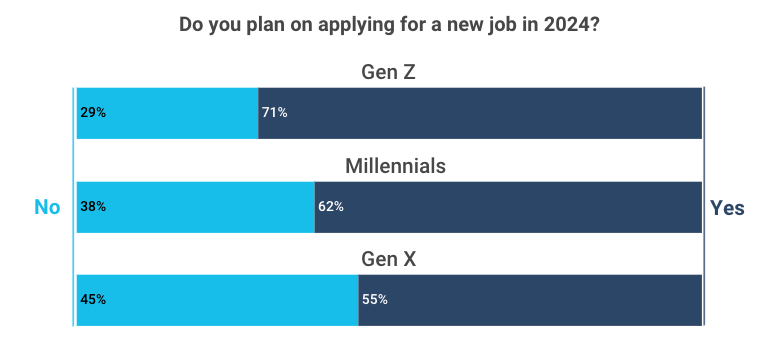
In the search for a better work/life balance, 63% of our respondents planned to apply for a new job in 2024. Zoomers — who are still building their careers and looking for better opportunities — were more likely to be job-hunting next year as 71% of the cohort responded “yes” to our question. For comparison, that figure stood at 55% for Generation X, who are more likely to have a steady career. Again, Millennials were in the middle with 62% planning to apply for a new job.
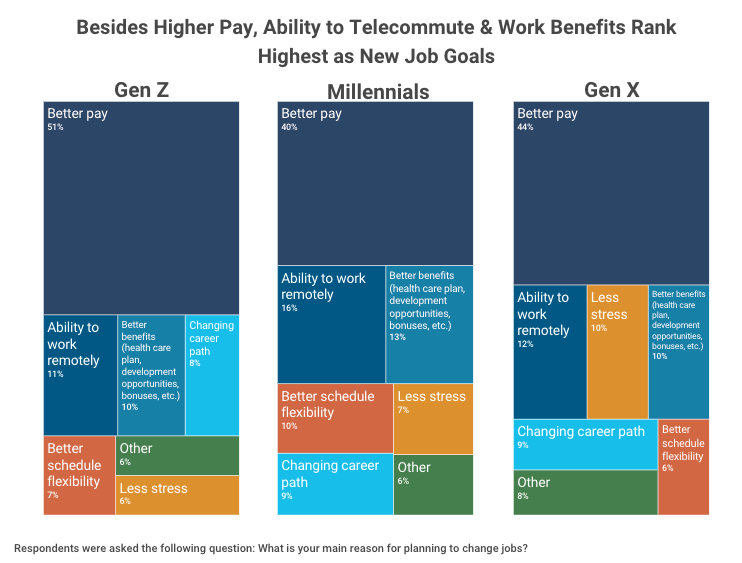
When asked to share the reason why they plan to change their workplace, 46% of respondents (and 51% of Gen Zers, in particular) said the primary reason is better pay. And, with job hopping receiving growing recognition as a way to achieve a better salary, it’s no surprise that most respondents looking for a career shake-up are looking for monetary benefits. At the same time, constant shifts in work environment — and potentially high workloads while learning the ropes — can contribute to issues highlighted earlier in the study, such as chronic stress.
Besides higher pay, workers are looking for other benefits in new jobs as well: Better health care plans, career development opportunities and bonuses represented the third most popular reason for job-hopping among survey respondents.
Notably, the ability to work remotely — which we’ve already established as a major factor in improving work/life balance for employees — was also a priority for job-hunters. In fact, remote work-readiness was the second-most popular reason for all cohorts to look for a new job.
The remaining respondents were mostly split on why they planned to change jobs. After the top three, Gen Z’s next answer was changing career path, while Millennials emphasized schedule flexibility and Gen X sought to reduce stress by changing their work environment.
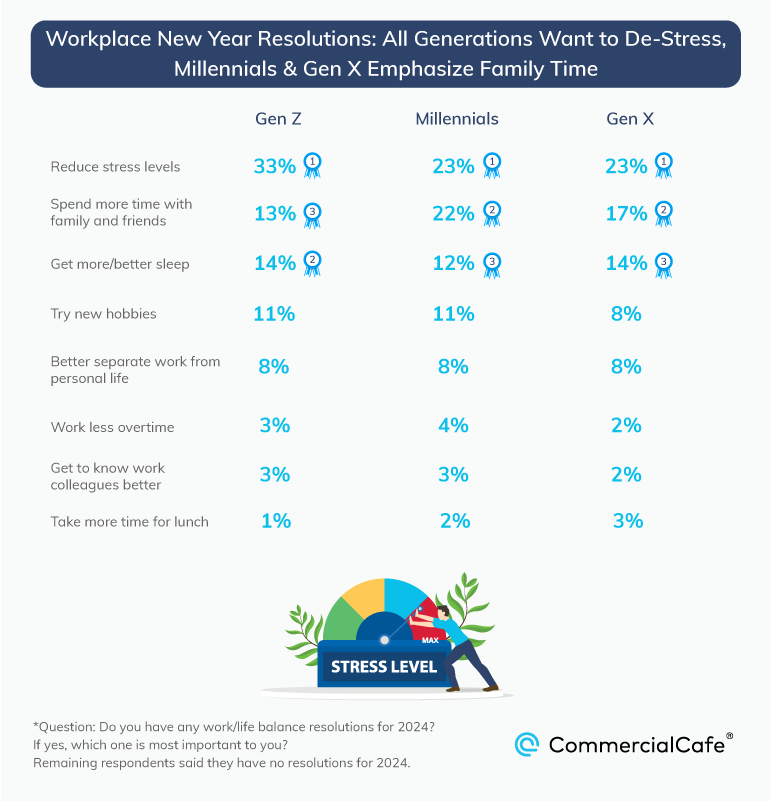
Finally, because the survey was run close to the end of the year, we also asked respondents about their New Year’s resolutions for 2024 related to their work/life balance. Clearly, Americans are aware and willing to change the issues affecting their workplace wellbeing as 80% of Gen Xers, 89% of Millennials and 90% of Gen Zers said they did have a work/life balance resolution.
Accordingly, in keeping with their perception of workplace stress, the most common resolution for our respondents was to reduce their stress level, which was chosen by one-third of Gen Zers and 23% of each of the two remaining cohorts.
Next, spending more time with family came in as a close second-place resolution for Millennials, selected by 22% of respondents in that age group. Quality time with loved ones was also the second-most popular resolution for Generation X. Lastly, getting better sleep (and more of it) was also a popular resolution as the second choice for Gen Z and in the top three for the other cohorts.
From high stress levels to not getting enough sleep and relying on loved ones to destress, these resolutions parallel the work/life balance woes that respondents previously identified. Thus, there is hope for improvement when it comes to balancing work and free time.
Methodology
Our survey included 1,377 respondents from the U.S., 35% of whom (484 responses) were Gen Z; 32% (437 responses) were Millennials; and 33% (456 responses) were Gen X. All respondents were older than 18. Age groups were defined as follows:
- Generation Z: Less than 26 years old
- Millennials: 27 to 41 years old
- Generation X: 42 to 56 years old
Survey responses were collected using Clickworker. The survey has a 5% margin of error and a 95% confidence level.
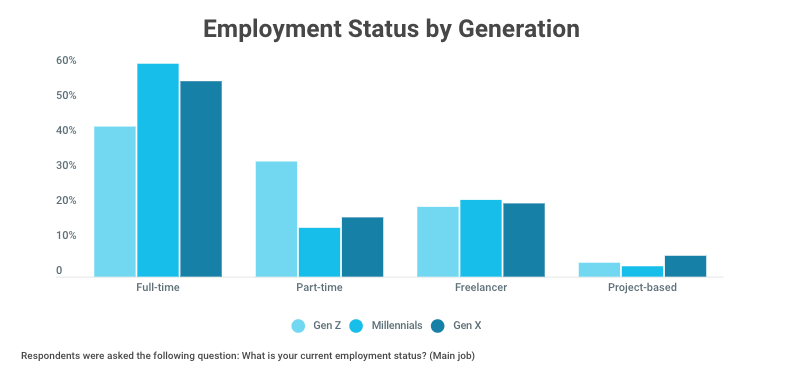
We also inquired about respondents’ employment status, and 53% of them stated they worked full-time. Otherwise, Millennials held the highest share of full-time jobs at 61%, followed by Gen X at 56%. Interestingly, part-time jobs were the most popular with Generation Z (33% of respondents). regardless of age said they work as freelancers.
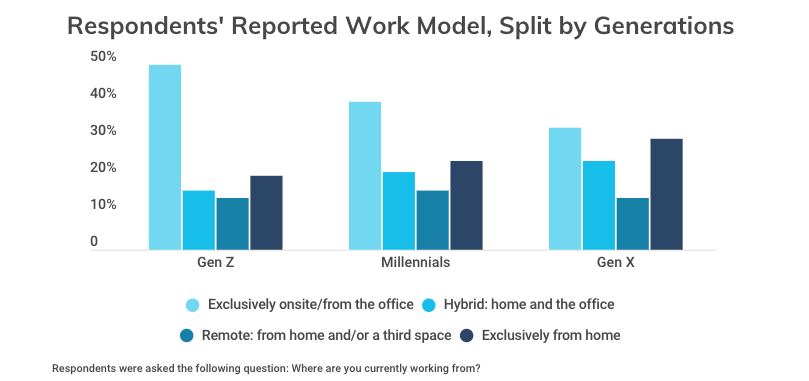
On average, 40% of respondents said they worked in-office or on-site; 39% worked remotely (either from home or another place other than the office); and the remaining 20% worked with a hybrid work model blending on-site and remote work. This high margin of remote work can be partly attributed to the fact that the survey was collected online.
Generation X respondents reported the highest remote work margin with more than 43% of respondents in this age group reporting that they worked fully remote. A further 24% of the members of this cohort said they were hybrid. Millennials followed with nearly 40% of respondents claiming they held remote jobs, while another 40% worked exclusively in-office. The lowest remote work share was held by Generation Z.
Related: The 2024 Customer Experience Thrill Ride: Trends, Projections & Tips

